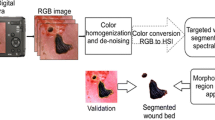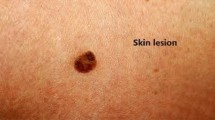Abstract
A skin ulcer is a clinical pathology of localized damage to skin and tissue instigated by venous insufficiency. Precise identification of wound surface area is one of the challenging tasks in the dermatological evaluation. The assessment is carried out by clinicians using traditional approach of scales or metrics through visual inspection. The manual assessment leads to intra-observer variability, subjective error and time complexity. This paper evaluates the performances of supervised and unsupervised segmentation techniques used for wound area detection. The unsupervised methods used for evaluation were namely K-means, Fuzzy C-means and Gaussian mixture model. On the other part, random forest was implemented for supervised classification. Several filtering methods were used to generate image feature set from wound images to train random forest. The Gaussian mixture model with classification expectation–maximization clustering method achieved the highest weighted sensitivity of 95.91% and weighted specificity of 96.7%. The comparative study shows the superiority of proposed method and its suitability in wound segmentation from normal skin.
Access this chapter
Tax calculation will be finalised at checkout
Purchases are for personal use only
Similar content being viewed by others
References
Cho, N.H., Whiting, D., Guariguata, L., Montoya, P.A., Forouhi, N., Hambleton, I., et al.: IDF Diabetes Atlas. International Diabetes Federation, Brussels, Belgium (2013)
Kailas, A., Chong, C.C., Watanabe, F.: From mobile phones to personal wellness dashboards. IEEE Pulse 1(1), 57–63 (2010)
Kecelj Leskovec, N., Perme, M.P., Jezeršek, M., Mozina, J., Pavlović, M.D., Lunder, T.: Initial healing rates as predictive factors of venous ulcer healing: the use of a laser-based three-dimensional ulcer measurement. Wound Repair Regen. 16(4), 507–512 (2008)
Lubeley, D., Jostschulte, K., Kays, R., Biskup, K., Clasbrummel, B.: 3D wound measurement system for telemedical applications. Biomedizimische Technik 50(1), 1418–19 (2005)
Chang, A.C., Dearman, B., Greenwood, J.E., et al.: A comparison of wound area measurement techniques: visitrak versus photography. Eplasty 11(18), 158–66 (2011)
Little, C., McDonald, J., Jenkins, M., McCarron, P.: An overview of techniques used to measure wound area and volume. J. Wound Care 18(6), 250–253 (2009)
Pavlovčič, U., Diaci, J., Možina, J., Jezeršek, M.: Wound perimeter, area, and volume measurement based on laser 3D and color acquisition. Biomed. Eng. Online 14(1), 1 (2015)
Hansen, G.L., Sparrow, E.M., Kokate, J.Y., Leland, K.J., Iaizzo, P.A.: Wound status evaluation using color image processing. IEEE Trans. Med. Imaging 16(1), 78–86 (1997)
Krouskop, T.A., Baker, R., Wilson, M.S.: A noncontact wound measurement system. J. Rehabil. Res. Dev. 39(3), 337 (2002)
Duckworth, M., Patel, N., Joshi, A., Lankton, S.: A clinically affordable non-contact wound measurement device (2007)
Mesa, H., Veredas, F.J., Morente, L.: A hybrid approach for tissue recognition on wound images. In: International Conference on Hybrid Intelligent Systems, pp. 120–125. IEEE (2008)
Aslantas, V., Tunckanat, M.: Differential evolution algorithm for segmentation of wound images. In: IEEE International Symposium on Intelligent Signal Processing, pp. 1–5. IEEE (2007)
Deng, Y., Manjunath, B.: Unsupervised segmentation of color-texture regions in images and video. IEEE Trans. Pattern Anal. Mach. Intell. 23(8), 800–810 (2001)
Dhane, D.M., Krishna, V., Achar, A., Bar, C., Sanyal, K., Chakraborty, C.: Spectral clustering for unsupervised segmentation of lower extremity wound beds using optical images. J. Med. Syst. 40(9), 207 (2016)
Kolesnik, M., Fexa, A.: Multi-dimensional color histograms for segmentation of wounds in images. In: International Conference on Image Analysis and Recognition, pp. 1014–1022. Springer (2005)
Treuillet, S., Albouy, B., Lucas, Y.: Three-dimensional assessment of skin wounds using a standard digital camera. IEEE Trans. Med. Imaging 28(5), 752–762 (2009)
Wannous, H., Lucas, Y., Treuillet, S.: Enhanced assessment of the wound-healing process by accurate multiview tissue classification. IEEE Trans. Med. Imaging 30(2), 315–326 (2011)
Veredas, F.J., Mesa, H., Morente, L.: Efficient detection of wound-bed and peripheral skin with statistical colour models. Med. Biol. Eng. Comput. 53(4), 345–359 (2015)
Medetec Medical Images: http://www.medetec.co.uk/files/medetec-images.html (2016)
Alpaydin, E.: Introduction to Machine Learning, 2nd edn. The MIT Press (2010)
Li, J.: Clustering based on a multilayer mixture model. J. Comput. Graph. Stat. 14(3), 547–568 (2005)
Arganda-Carreras, I., Kaynig, V., Schindelin, J., Cardona, A., Seung, H.: Trainable weka segmentation: a machine learning tool for microscopy image segmentation (2014)
Breiman, L.: Random forests. Mach. Learn. 45(1), 5–32 (2001)
Acknowledgements
The first author acknowledges CSIR for financial support (09/81(1223)/2014/EMRI dt. 12-08-2014). The second and third author would like to acknowledge ICMR, GoI, (Grant number: DHR/GIA/21/2014, dated 18 November, 2014).
Author information
Authors and Affiliations
Corresponding author
Editor information
Editors and Affiliations
Rights and permissions
Copyright information
© 2018 Springer Nature Singapore Pte Ltd.
About this paper
Cite this paper
Maity, M., Dhane, D., Bar, C., Chakraborty, C., Chatterjee, J. (2018). Assessment of Segmentation Techniques for Chronic Wound Surface Area Detection. In: Bhattacharyya, S., Chaki, N., Konar, D., Chakraborty, U., Singh, C. (eds) Advanced Computational and Communication Paradigms. Advances in Intelligent Systems and Computing, vol 706. Springer, Singapore. https://doi.org/10.1007/978-981-10-8237-5_68
Download citation
DOI: https://doi.org/10.1007/978-981-10-8237-5_68
Published:
Publisher Name: Springer, Singapore
Print ISBN: 978-981-10-8236-8
Online ISBN: 978-981-10-8237-5
eBook Packages: EngineeringEngineering (R0)




